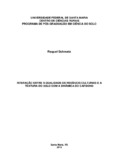| dc.creator | Schmatz, Raquel | |
| dc.date.accessioned | 2017-04-10 | |
| dc.date.available | 2017-04-10 | |
| dc.date.issued | 2016-01-08 | |
| dc.identifier.citation | SCHMATZ, Raquel. Interaction between the quality of crop residues and texture soil with carbon dynamic. 2016. 62 f. Dissertação (Mestrado em Agronomia) - Universidade Federal de Santa Maria, Santa Maria, 2016. | por |
| dc.identifier.uri | http://repositorio.ufsm.br/handle/1/5617 | |
| dc.description.abstract | The chemical quality of crop residues is considered the primary driver of the dynamics of
carbon and stabilization of soil carbon (C) from the crop residues (C-new) depend on the soil
texture. The aim of this study was to evaluate the quality of crop residues and soil texture on
the decomposition and the quantity of C-new in the soil the short term. The incubation
experiment was conducted for 180 days in Ultisol and Oxisol soils with contrasting texture
and three crop residues enriched with 13C, wheat (Triticum aestivum), pea (Pisum sativum L.)
and vetch (Vicia sativa L.) under conditions controlled temperature and humidity in the
LABCEN of the Department of Soil Science at UFSM. The experiment was conducted in a
completely randomized design with three replications and eight treatments: T1- Soil Ultisol
(SU); T2- Soil Oxisol (SO); T3 - SU + straw wheat; T4 SU + straw pea; T5- SU + straw vetch;
T6- SO + straw wheat; T7- SO + straw pea; and T8- SO + straw vetch. The evaluation of the
mineralization of C was carried out through the release of CO2 and 13C was evaluated by
measuring 13CO2 released during decomposition of crop residues, always in the same
bottles. Six evaluations were released to determine the quantity of C and 13 C remaining in
the crop residues and the soil, and recovery of 13C. The quality of crop residues and the soil
texture affect the mineralization of C of crop residues. The early stage of decomposition,
highest mineralization the C was found with the residue vetch, and at the end of the
experiment, the residues of wheat had the highest quantity of C mineralized and in the sandy
soil. The quantity C-new of soil from the shoots plants, of wheat, pea and vetch is not
affected by the quality of crop residues and the soil texture. | eng |
| dc.description.sponsorship | Coordenação de Aperfeiçoamento de Pessoal de Nível Superior | |
| dc.format | application/pdf | por |
| dc.language | por | por |
| dc.publisher | Universidade Federal de Santa Maria | por |
| dc.rights | Acesso Aberto | por |
| dc.subject | Isótopo 13C | por |
| dc.subject | Decomposição | por |
| dc.subject | Mineralização | por |
| dc.subject | 13C isotope | eng |
| dc.subject | Decomposition | eng |
| dc.subject | Mineralization | eng |
| dc.title | Interação entre a qualidade de resíduos culturais e a textura do solo com a dinâmica do carbono | por |
| dc.title.alternative | Interaction between the quality of crop residues and texture soil with carbon dynamic | eng |
| dc.type | Dissertação | por |
| dc.description.resumo | A qualidade química dos resíduos culturais é considerada o controlador primário da
dinâmica do carbono (C) e a estabilização do C no solo proveniente dos resíduos (C-novo)
dependem da textura do solo. O objetivo deste estudo foi avaliar o efeito da qualidade de
resíduos culturais e da textura do solo sobre a decomposição e a quantidade de C-novo no
solo a curto prazo. O experimento de incubação foi conduzido por 180 dias em solos
Argissolo e Latossolo, com textura contrastante e com três resíduos culturais enriquecidos
com 13C, trigo (Triticum aestivum), ervilha (Pisum sativum L.) e ervilhaca (Vicia sativa L.) em
condições controladas de temperatura e umidade no Laboratório de Pesquisas em
Biotransformações do C e N do Departamento de Solos da UFSM. O experimento foi
instalado no delineamento inteiramente casualizado, com três repetições e oito tratamentos,
sendo: T1- Solo Argissolo (SA); T2- Solo Latossolo (SL); T3 - SA + palha de trigo; T4- SA +
palha de ervilha; T5- SA + palha de ervilhaca; T6- SL + palha de trigo; T7- SL + palha de
ervilha; e T8- SL + palha de ervilhaca. A avaliação da mineralização do C foi realizada
através da liberação de CO2 e o 13C foi avaliado através da quantificação do 13CO2 liberado
durante a decomposição dos resíduos culturais, sempre nos mesmos frascos. Foram
realizadas seis avaliações para a determinação da quantidade de C e 13C remanescentes
nos resíduos e no solo, assim como a recuperação do 13C. A qualidade dos resíduos e a
textura do solo afetaram a mineralização do C dos resíduos culturais. Na fase inicial de
decomposição maior mineralização de C foi encontrada com os resíduos de ervilhaca sendo
que ao final do experimento os resíduos de trigo apresentaram a maior quantidade de C
mineralizado e no solo arenoso. A quantidade de C-novo no solo proveniente da parte
aérea de plantas de trigo, ervilha e ervilhaca não é afetada pela qualidade dos resíduos
culturais e pela textura do solo. | por |
| dc.contributor.advisor1 | Giacomini, Sandro José | |
| dc.contributor.advisor1Lattes | http://lattes.cnpq.br/1112466940331009 | por |
| dc.contributor.referee1 | Ferreira, Paulo Ademar Avelar | |
| dc.contributor.referee1Lattes | http://lattes.cnpq.br/1871733582967061 | por |
| dc.contributor.referee2 | Redin, Marciel | |
| dc.contributor.referee2Lattes | http://lattes.cnpq.br/7912908707815307 | por |
| dc.creator.Lattes | http://lattes.cnpq.br/0968932074931599 | por |
| dc.publisher.country | BR | por |
| dc.publisher.department | Agronomia | por |
| dc.publisher.initials | UFSM | por |
| dc.publisher.program | Programa de Pós-Graduação em Ciência do Solo | por |
| dc.subject.cnpq | CNPQ::CIENCIAS AGRARIAS::AGRONOMIA::CIENCIA DO SOLO | por |


